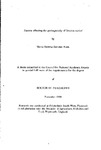Factors affecting the pathogenicity of Yersinia ruckeri
| dc.contributor.author | Nozal, Maria Dolores Furones | |
| dc.contributor.other | School of Biological and Marine Sciences | en_US |
| dc.date.accessioned | 2013-11-01T13:08:36Z | |
| dc.date.available | 2013-11-01T13:08:36Z | |
| dc.date.issued | 1990 | |
| dc.identifier | NOT AVAILABLE | en_US |
| dc.identifier.uri | http://hdl.handle.net/10026.1/2543 | |
| dc.description.abstract |
A group of 42 strains of Yersinia ruckeri were characterized and found to show homogenous biochemical profiles. The optimal conditions for in vitro culture of a representative strain of Y. ruckeri were established. The virulence was increased by passage through fish. A standard method for infection of rainbow trout (Oncorhynchus mykiss) with Y. ruckeri was devised. As a result cultures of Y. ruckeri grown on full strength of BHIA for 5 h at 30°C in static conditions were found to be most suitable for infection by both intraperitoneal injection and immersion. Virulence of stored cultures was maintained for over 1 year at -20 and/or -70° C and virulence was not lost after up to six consecutive subcultures. The effect on mortality of susceptibility of various fish stocks, water temperature and stocking density is described. The size of fish (between 5 and 60 g) had no effect on virulence. The injection and immersion protocols were used as in vivo models for the study of the effects of dietary vitamin E, with both laboratory prepared diets and commercially available diets. Comparative results of haematological and biochemical parameters, histology, mortality patterns, serum antibody levels and bacterial recovery from the four dietary groups of fish are presented. A comparative in vitro and in vivo study of intra and inter strain vanations among representatives of the serogroup 1 of Y. ruckeri was performed. Under the conditions used, some strains were virulent and other avirulent. Results of Western blotting and SDS-PAGE showed the presence of a heat sensitive factor (HSF), present only in the virulent strains of Y. ruckeri. To date this is the first putative virulence factor described for Y. ruckeri. Further work was undertaken in an attempt to characterize the HSF. It appears to be located in the periplasmic space and to have complex lipid and proteinaceous components. HSF is easily degraded, and is immunogenic and confers some protection when injected into rainbow trout. Selective media and detection methods for the HSF, and their potential use in laboratory and field studies are described. | en_US |
| dc.description.sponsorship | The Ministry of Agriculture, Fisheries and Food, Weymouth, England | en_US |
| dc.language.iso | en | en_US |
| dc.publisher | University of Plymouth | en_US |
| dc.title | Factors affecting the pathogenicity of Yersinia ruckeri | en_US |
| dc.type | Thesis | |
| plymouth.version | Full version: final and full version as approved by the examiners at the time of the award of your degree | en_US |
| dc.identifier.doi | http://dx.doi.org/10.24382/4242 | |
| dc.identifier.doi | http://dx.doi.org/10.24382/4242 |
Files in this item
This item appears in the following Collection(s)
-
01 Research Theses Main Collection
Research Theses Main


